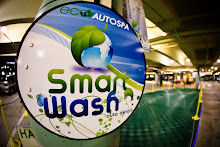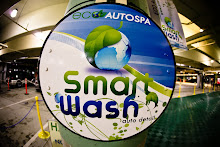Have you seen our video? No, you say? Well then...here it is!
Wednesday, December 24, 2008
Monday, December 22, 2008
How Often Should I Wax My Car?
I am often asked by my clients how often they should have their car waxed, and in talking with them more about it I learn that their is quite a bit of misinformation about this topic. What I'd like to talk about in this posting is how often you should get your car waxed when presented with different types of waxes.
Not all wax jobs are created equal. One key element that should be part of any wax job is the clay treatment. If your detailer isn't using detailer's clay to prep your vehicle's surface before the wax application process, then you may want to consider either telling him you require that treatment or taking your vehicle to a place where they will clay before waxing. Waxing without claying first is like painting without priming. So, your first consideration should be to make sure your car is getting a full body clay treatment*.
Once you've determined that your detailer is using clay it is important for you to know what kind of wax you are paying for. I don't mean what kind of brand is being used but instead what kind of wax it is. Waxes come in at least 4 varieties: carnauba spray, carnauba lotion/paste, polymer sealants and carnauba show glazes**. So, what kind of wax is your detailer using? How this question is answered will depend on how often you should have your car waxed. It is with that idea in mind that we can begin our discussion. In this post I will cover the first of the wax categories and will discuss the other three in upcoming blogs.
CARNAUBA SPRAY WAX
Although this kind of wax has gotten a bad rap over the years as being a cover up wax or a shine enhancer that characterization is no longer accurate. It is now the case with the application of nano technology to auto detail chemical manufacturing that these spray waxes can be a very good alternative for people who have their cars washed so often that spending extra money on a lotion wax makes little sense.
If the vehicle is clayed properly, a spray wax like the one that is used at Smart Wash (Smart One or Smart UV) will last 45 to 60 days in our Georgia/South East climate. Other spray waxes like Turtle Wax Ice also provide great protection although I can't vouch for their friendliness to our environment. These kinds of waxes lasted for only two weeks some years ago but as I said before with the application of newer technologies to the manufacturing process the longevity and effectiveness of these waxes has increased dramatically. So, if you get your car cleaned pretty regularly paying anywhere from $35 to $50 for a premium spray wax may be worth it. You'll probably need to get it done 6 times per year. You average yearly cost is $255 plus the cost of your regular washes.
* At Smart Wash we clay every vehicle that gets a wax job.
** Yes, there are many other kinds of waxes, as many different kinds as there are detailers it seems but for our purposes here let's stick to these as they are the most prevalent.
Saturday, December 13, 2008
The Benefits of Automotive Clay
Part of doing a good detail job on a car is making sure that you clay the car's paint thoroughly. Not only does the clay leave a better finish, remove many harmful surface contaminants from your paint, but it also allows your wax job to last longer.
But, what is clay? People ask me this all the time and understandably so. I mean, clay is something that auto enthusiast (you know, those people who love their cars so much that it boarders on insanity...like me for example when I had my MINI) have used for years. Clay is a piece of puddy that when rubbed on the painted surface of a car it removes any contaminants that have gotten into the pores of the paint.
But, what is clay? People ask me this all the time and understandably so. I mean, clay is something that auto enthusiast (you know, those people who love their cars so much that it boarders on insanity...like me for example when I had my MINI) have used for years. Clay is a piece of puddy that when rubbed on the painted surface of a car it removes any contaminants that have gotten into the pores of the paint.
You see, paint is porous like your skin and like your skin sometimes you need to use those Bio re pore strips to get all the junk that's in your pores out before you have a gnarley zit breakout! Well, that's kind of how clay works. Or think of it as a way of exfoliating paint - once you've clayed the car the paint is ultra smooth and ready for protection like when you exfoliate your skin it makes your skin soft and ready to get all lotioned up with Suave or CoCo Butter or whatever! :)
Check out these diagrams of vehicle paint before and after clay:
So, as you can see, clay really makes a huge difference! But making the surface smooth and clean is not the only benefit. In addition to allowing the wax to adhere better to the painted surface, clay also causes your car to look shinier and glossier when the wax is added. The gloss is much deeper and more rich and that is due to the fact that the wax has been applied to paint and not to paint embedded with dirt, grime, industrial fallout etc. I guess a good example would be that when you get your nails done the glossy clear they add at the end is much shinier because they polished your nails before hand rather than just slapping some clear gloss on your nails and that's it.
So, that is what clay is and that is what it does. Pretty cool stuff, huh? The Japanese invented it...I guess it makes up for their invention of Hello Kitty and Japan-imations! :)
Labels:
atlanta,
atlantic station,
auto detailing,
clay,
eco wash,
eco-friendly car care,
smart wash
Subscribe to:
Posts (Atom)









